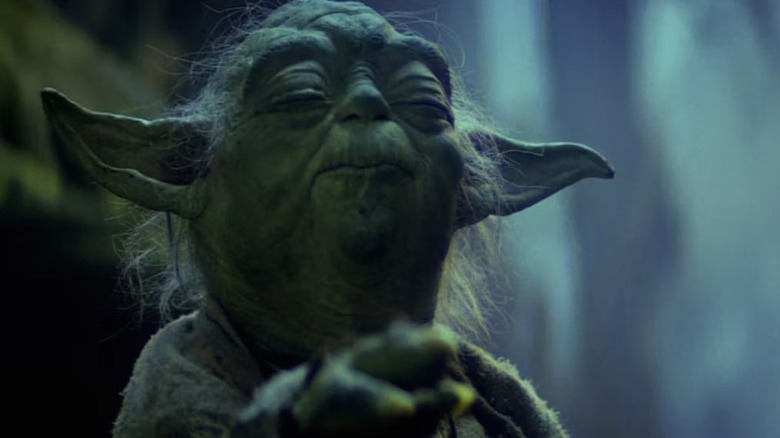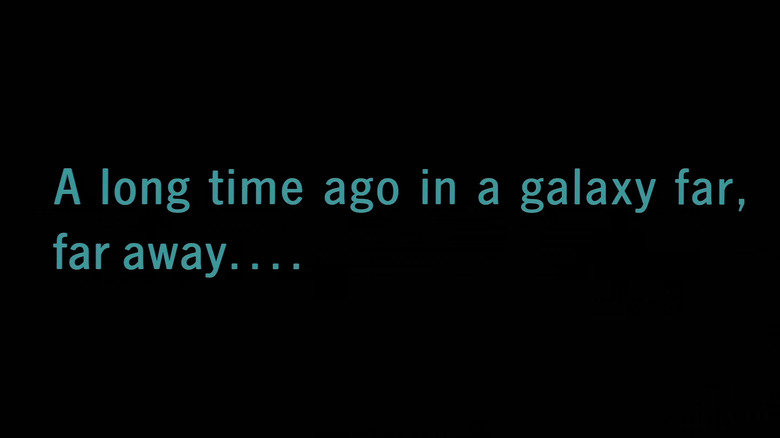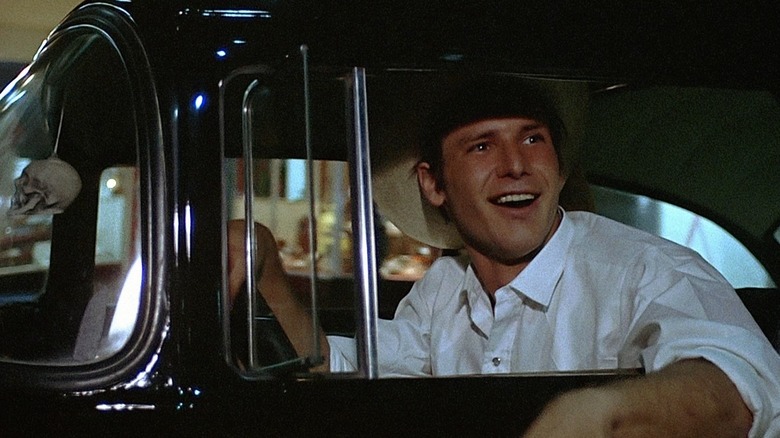This Short Film Explains Star Wars Creator George Lucas' Entire Filmography
On the red carpet for the premiere of "Star Wars: The Force Awakens" in 2015, filmmaker George Lucas — who sold "Star Wars" to Disney in 2012 — was relaxed and composed. He talked to reporters, and spoke dismissively of "Star Wars," seemingly over it all, and having washed his hands of the massive media empire he created.
Lucas mentioned that he was making new movies in his spare time, but that they were personal, weird, abstract shorts that no one would ever be allowed to see. After helping to pioneer a new wave of over-moneyed Hollywood glut, Lucas wanted to remind people that he was, after all, a filmmaker. It seems that after decades of having to shepherd the "Star Wars" media empire, he could get back to the low-budget college-level shorts he always wanted to make.
Indeed, Lucas has always been clear about the sort of movie he always wanted to make. According to a 2016 article in CBC, Lucas once wrote a letter to Canadian filmmaker Arthur Lipsett about a short he made in 1963 called "21-87."
"21-87," which is readily available online, is a nine-and-a-half minute abstract collage film that Lipsett constructed mostly out of discarded footage left on the floor of the National Film Board editing room. Lipsett was working there as an animator at the time, and he assembled "21-87" with some of his own footage shot guerilla style on the streets of Montreal and in New York. There is footage of people getting on a subway, of playing in a lake, of going to the circus.
Not only does "21-87" contain notions of what Lucas would call eventually The Force in "Star Wars," but it also illustrates the abiding pessimism he felt about the future.
The real dark side of the Force
About three-and-a-half minutes into "21-87," Lipsett capture a portion of an interview, subjects unknown, wherein two people are discussing the eerie interconnectivity of all things. But in "21-87" that vast interconnectivity, is, however, not presented as a positive influence. Indeed, vast notions of spiritual interconnectivity, the dialogue goes, robs people of individuality. The speech runs:
"Many people feel that in the, sort of, contemplation of nature and in communication with other living things, they become aware of some kind of ... Force or something behind this apparent mask which we see in front of us. And they call it God, depending on their particular disposition. [Thoughts of] some aspect of it. To me, it's not the same thing as a world full of human beings. There's something gone. There's something missing."
To that dialogue, another subject gives the short its name, saying:
"Then the people say, 'This is good! Let's have more of it.' Somebody walls up and says 'your number is 21-87, isn't it?' And, boy, does that person really smile."
The conversation seems to be saying that numbered conformity goes hand-in-glove with societal interconnectivity. A vast Jungian network of shared unconsciousness, these two men seem to think, is the same as sacrificing individuality. The Force, they say, doesn't have a light side. It's the main contributor to a damaging sense of unity. Like Nietzsche, they are casually rejecting notions of Forces or beings higher than the self.
George Lucas ultimately switched the notions in "21-84" around into vaguely upbeat religious beatitudes — "May the Force be with you" — but he was careful to say that the Force has a dark side. There is something damaging about that shared psychic energy.
George Lucas has never directed a film set in the present
In dialogue, the dark side of the Force alludes to a psychic field of hate, wrath, and ambition that Force-using practitioners can mentally tap into. The dark side provides them with superpowers and wicked motivations, but seems to dampen their conscience. That is an alteration from "21-87" which states clearly that the Force itself is kind of the dark side. There is no "light side" to a Force that sweeps up and erases individuals. Whether they give themselves to the light side or the dark side, they are succumbing to a mental field that erases them. "21-87" is an atheist text, rejecting asceticism.
Lucas has said that he is a "Methodist Buddhist," having been raised in a Protestant church, but attracted to notions of enlightenment. The text of "21-87" was filtered through Lucas' own sense of spirituality. Weirdly enough, he could also be seen as a Messianic figure in a new type of secular religion centered on pop-culture worship. There is an irony about Lucas creating a text based on analyzing and deconstructing religious ideas and accidentally creating a new religion in the process.
It's also worth remembering that George Lucas has never directed a film set in the present day. Lucas has only directed six feature films, with one set in the near future, and five set in the halcyon past. His 1971 film "THX 1138" takes place in an emotionless dystopia where people have numbers instead of names — also an echo of "21-87" — and where drugs and automated therapy have replaced connection and passion and humanity. Sex is forbidden and a weird new religion is mandated by the state.
Lucas looks to the future and sees only bleak horrors.
The comfort of the past in George Lucas' movies
Note the skull in the above photograph. It may be the same skull that accompanies the title card of "21-87."
After "THX 1138," Lucas retreated into the past, into the familiar, into the comfortable. Set in Modesto, California in 1962, Lucas' 1973 film "American Graffiti" was a nostalgic look at the car-and-diner culture the filmmaker grew up with. It was a "last night of summer vacation" elegy to placid, idealized youth. The characters raced cars, ate meals, and desperately sought sex ... or at least a conversation with a pretty girl. Growing up was inevitable, but there was a frantic need to keep youth going, to capture the last few remnants of being a youth before terrifying, terrifying adulthood caught up. The future was scary, and the past was comfortable.
The next four films Lucas directed (made from 1977 through 2005) were all set "a long time ago." The "Star Wars" films were, as many know, a recreation of the enjoyably clunky 1930s sci-fi serials Lucas watched as a youth. He wanted modern adult audiences to experience the same kind of thrill and exhilaration he felt as a kid, updating "Flash Gordon" with a new mythos and cutting-edge special effects. By extension, all of "Star Wars" serves as nostalgia. We may have become a little too involved in its myth and lore and worldbuilding, yadda yadda yadda, but "Star Wars" is just another attempt by Lucas to look to the past.
A skeleton key to Lucas' philosophy, "21-87" might be seen as the pivot point in Lucas' career. It's the fulcrum of the present. It's when an ideal past soured and become the bleak future. "21-87" is when time finally slipped past us, dissolving youthful assurances, and leading to a sexless, nameless, hopeless future.



